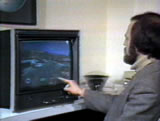Theory / Research
Aspen Moviemap was one of the first interactive video projects ever. Seeded many others and in part led to the vision of the MIT Media Lab.
The Aspen Moviemap led to several moviemaps since.
FOLLOW-UP PROJECTS
The author has since conceived and directed several moviemap productions, each with its own unique playback configuration. The "Paris VideoPlan" (1986) was commissioned by the RATP (Paris Metro) to map the Madeleine district of Paris from the point-of-view of walking down the sidewalk. It was filmed with a stop-frame 35mm camera mounted on an electric cart, filming one frame every 2 meters. An encoder was attached to one of the cart's axles. Rather than filming all the turn possibilities at each intersection, a mime was employed to stand in each intersection and simply point in the possible turn directions. The idea was to substitute the perceptual continuity of actual match-cuts with cinematic continuity. The playback system was built in a kiosk and exhibited in the Madeleine Metro Station.
The "Golden Gate Videodisc Exhibit" (1987) was produced for San Francisco's Exploratorium as an aerial moviemap over a 10 by 10 mile grid of the Bay Area. It was filmed with a gyro-stabilized 35mm motion picture camera on a helicopter, which flew at a constant ground speed and altitude along one-mile grid lines determined by LORAN satellite navigation technology, effectively filming one frame every 30 feet. The camera was always pointed at the center of the Golden Gate Bridge, hence no turn sequences were necessary since the images always matched at each intersection regardless of travel direction. The playback system used a trackball to control both speed and direction, with the feel of "tight linkage" to the laserdiscs. The result was the sensation of moving smoothly over the Bay Area at speeds much faster than normal.
"VBK: A Moviemap of Karlsruhe" was commissioned by the Zentrum fur Kunst und Medientechnologie (ZKM). Karlsruhe, Germany, has a well-known tramway system, with over 100 kilometers of track snaking from the downtown pedestrian area out into the Black Forest. A 16mm stop-frame camera was mounted in front of a tram car and interfaced to the tram's odometer. Triggering was programmed to be at 2, 4, or 8 meter increments per frame depending on location. Filming on a track resulted in virtually perfect spatial registration. The playback system consisted of a pedestal with a throttle for speed control and 3 pushbuttons for choosing direction at intersections. The camera had a very wide-angle lens (85 degree horizontal FOV) and playback employed a 16 foot wide video projection. The input pedestal was strategically placed in front of the screen to achieve orthoscopically correct viewing, resulting in a strong sense of visual immersion.
(M. Naimark)
Publications
- M. Naimark, A 3D Moviemap and a 3D Panorama, SPIE Proceedings Vol. 3012, San Jose, 1997
» http://www.naimark.n…t/writing/spie97.html
Secondary Literature
- R. Mohl, Cognitive Space in the Interactive Movie Map: An Investigation of Spatial Learning in Virtual Environments, PhD dissertation, Education and Media Technology, M.I.T., 1981


